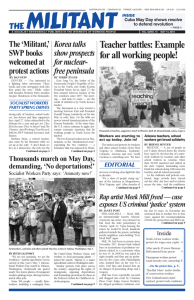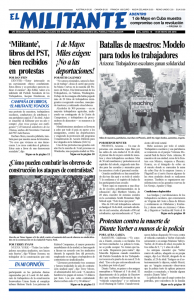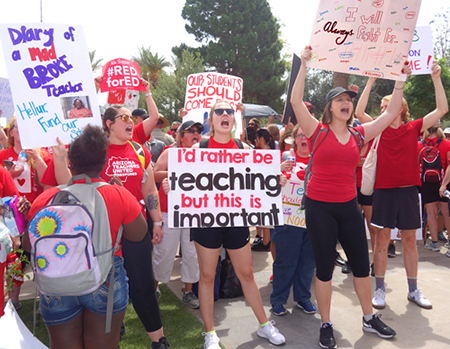PHOENIX — A sea of people in red T-shirts flowed down the streets here April 26, the first day of a statewide walkout by teachers and other school workers in Arizona. More than 50,000 marched and rallied at the state Capitol, demanding more funds for schools along with raises for teachers and all school personnel.
As the walkouts and protests continued, large crowds have turned out day after day here and in actions across the state. And the confidence and fighting spirit of participants have grown.
The RedForEd Spirit Band, playing brass and drums, led a mighty chorus in singing, “We’re not going to take it any more.” The Twisted Sisters tune has become the signature of the school workers’ mobilizations across the country.
“I’m here because of a decade of the government cutting education,” said Matthew Martin, 28, a social studies teacher at South Mountain High School here. “There has to be a stopping point.”
More than 100,000 school workers walked out April 26, closing some 1,000 schools, affecting 850,000 students, roughly 75 percent of the state’s enrollment. The protesters are renowned for their creative signs, such as “35 is a speed limit, not a class size.”
Those who couldn’t make it to the Capitol rallied in cities across the state. While 30 teachers from Sierra Vista, close to the Mexican border, traveled to Phoenix, school workers and supporters gathered at that city’s Veterans Memorial Park, wearing red and waving signs. Kearny, in the copper triangle in the southeast where Asarco’s Ray copper mine is located, and Flagstaff in the north were among the cities where actions took place. Some of the marchers had T-shirts sporting “Red for Ed on the Rez,” and demonstrations were organized on the state’s sizable Navajo, Apache and Hopi reservations.
Deplorable conditions
The school workers strikes and mobilizations, which started in West Virginia in late February and continued in Oklahoma and Kentucky, have now moved into Arizona and Colorado and will hit North Carolina May 16. The North Carolina Association of Educators, the state affiliate of the National Education Association union, has called a statewide protest at the Capitol. These fights have shone the spotlight on some of the truly deplorable conditions working people face.
Lights are out in the schools, heat isn’t on in the hallways, pipes are leaking, textbooks — when teachers have them — are falling apart and there are up to 40 students in a classroom. Teachers pay hundreds, sometimes $1,000, out of pocket for supplies, clothes for kids, even food. In Oklahoma, 20 percent of the schools work on four-days-a-week schedules.
The fact is the propertied rulers don’t care if schools are crumbling. Their kids go to private academies and Ivy League schools to learn to be rich. Workers, they’re convinced, don’t need much learning. As a matter of fact, they think literate and cultured workers are dangerous.
“We need funding,” said Yvanna Villa, a kindergarten teacher at Red Bird Elementary School here. “When I left for the walkout, everything in my classroom except desks, tables and chairs are things I provided.”
Workers in Arizona demand a 20 percent pay raise for teachers, raises for all other school workers and restoration of funding to its 2008 level, which would require an additional $1 billion. Median pay for Arizona teachers is one of the lowest in the country.
“It’s hard to meet their needs, when there are 32 students in the classroom. I feel spread thin. I don’t have pencils, paper, I have to buy them,” said Nancy Neff who teachers eighth-graders. “I joined my union. I’m hoping it grows in power and right to work goes away.”
Arizona is one of 28 right-to-work states, as are North Carolina, Oklahoma, Kentucky and West Virginia. The state legislature sets pay levels and benefits. Alabama, Mississippi, New Mexico, South Dakota and Utah are other states with the same setup. In addition to demanding increased school funding and wages, protests have targeted pension cuts and rising health premiums.
‘Build the union back up’
Arizona Educators United, a Facebook-based group for all those who work in the schools, started up in early March. It now has 52,000 members and has led the mobilizations. They’ve built a network of “liaisons” in schools across the state and work together with the Arizona Education Association, the largest union for school workers.
Union and nonunion workers from public schools and some charter schools have been drawn into the growing movement. They’ve joined discussions and actions, which culminated April 11 with more than 100,000 participating in walk-ins at over 1,000 schools. They took part in the April 17-19 vote that decided to walk out, where some 57,000 workers cast their votes with 78 percent in favor.
“The union is only good as far as it reaches,” said one-year teacher Sibel Duzenli from Tucson. “I want to join and be part of building that back up.”
State legislators have tried to divide the workers. Arizona Gov. Doug Ducey has proposed a 20 percent pay raise for the teachers, making no mention of raises for other workers, or of any funding to improve school conditions.
Crystal Butler has worked as an instructional assistant for two years. She makes $10.50 an hour and works only 30 to 32 hours a week. “The governor’s proposal only covers classroom teachers and not support staff. I work in the reading lab so I wouldn’t get the raise,” she said. The only way she and others got increased pay was after a state referendum was passed that raised the minimum wage from $10.01 to $10.50. Like many other workers hoping for change, she voted for Donald Trump in the 2016 presidential election.
In Arizona the bosses familiar tactic of red-baiting has reared its head. In an April 25 opinion piece in the Arizona Republic, Maria Syms, a statehouse representative, railed at Noah Karvelis, a leader of Arizona Educators United, saying he was “channeling Lenin” to push “a national socialist revolution.” Her evidence? He campaigned for Bernie Sanders and says that “we must continue our fight and bolster the working class.”
Karvelis spoke at the April 30 rally. “We are going to come away with a win,” he said. “We are changing history.”
Broad support, social movement
The protests and walkouts have inspired workers and mobilized broad support across the country. Workers are hungry for a fight after decades of being pushed back by Democrats and Republicans in the White House and state legislatures.
Some 15 members of the United Association Local 469, which organizes plumbers and pipefitters, brought 11,000 water bottles to the rally here, helping participants get some relief from the 100-degree heat. Trevor Derry, one of 30 members from the United Food and Commercial Workers, who work at area supermarkets, spent most of the day at the Capitol. He said he thought the school workers “knocked it out of the park.”
“Welcome to the labor movement, brothers and sisters,” Jim McClaughlin, president of UFCW Local 99, said when he spoke at the rally April 30.
The organization of the walkout as a broad social movement helps win solidarity and cuts across attempts to divide and defuse. Taking the lead from West Virginia, school workers have reached out to involve students, parents and other workers in the fight. Volunteers are gathering food for the many students who depend on school meals. Churches, community centers and families open their doors to students so their parents don’t have to miss work.
“We are providing breakfast and lunch in the schools,” said Katie Wood, a sixth-grade teacher from Flagstaff, who traveled here to rally outside the Capitol. “We are making history! A lot of us thought there was nothing we could do about the situation, but we are doing it.”


